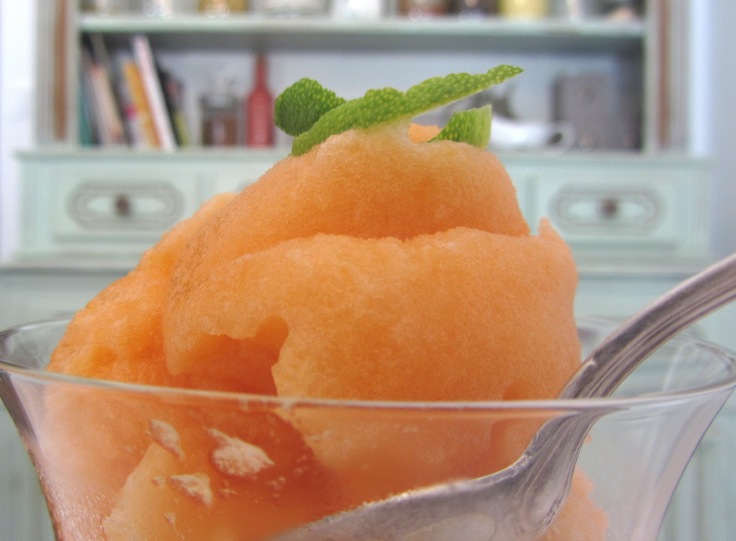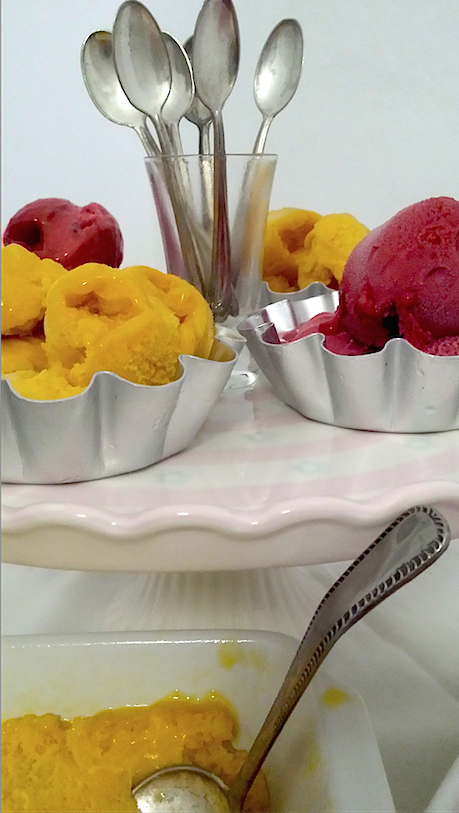
Today I am sharing with you a another summer dessert only this is not grainy like a granita. Many people use a machine for this but there is a way to achieve machine smoothness without an ice cream maker with a simple and easy technique. In sophisticated restaurants guests are often served a sorbet in between courses as it acts as a palette cleanser. Now you can do the same and impress your guests at home, that’s how uncomplicated sorbet making actually is. Or if you’re like me, you can make sorbets just to eat it and feel really wonderful when the warmth of the sun can be felt in just about every place in the house. Forget sundowners, on scorching days I need a cool downer and sorbets rank in my list of favourites. Sorbets are lovely because it’s full of natural goodness which makes them especially good for children. It is a clever way of getting kids to eat more fruit and less of the industrial, artificial stuff without having to prompt them. The sorbet, unlike the granita is smooth and velvety on the tongue and doesn’t have that grainy texture so don’t feel like this is a repetition of granita making, because you’ll find that they do have differences as depicted below with the melon sorbet and a watermelon granita. Once you master both processes you can decide which of the two you prefer. As for me I love both.
There are so many variations of sorbet we can make because lucky for us the main ingredient is fruit. Just about any fruit can be used for sorbets, as well as a mix of fruit, cooked fruit, roasted fruit except for dried fruit. In Italy the melon sorbet or sorbetto di melone is a crowd pleasing favourite. It is made from the Cantaloupe melon (as known all over Europe) that derives its name from the Italian village “Cantalup”. It has a rough skin on the outside with light orange-coloured flesh on the inside. They are at their peak in the summer time so they can not be mistaken for the honey dew melon which in contrast has a smooth skin on the outside and green-coloured flesh within and is more of a winter fruit. Isn’t nature wonderful – it does all our homework for us! I’ve always been in love with cantaloupe melons or spanspek as it is called in South Africa, since the first time I tasted them. They have an unmistakable flavour which seeps through into the smell, or is that vice versa? Anyway what does it matter, all I know is that I can eat an entire melon cut into chunks while watching Colin Firth in Magic in the Moonlight, like somebody else would eat popcorn. If you’re unfamiliar with the cantaloupe or have just never tried it, allow me to sing its praises. These melons are best known for their musky aroma hence the nickname “musky melon” in some parts of the world. The unmistakable musky smell emanates best from completely ripened fruit so remember that the next time you buy one or want to ripen one at home. While it may seem like a perversion to fellow shoppers in the market, sniffing cantaloupes is a must and a joy. I won’t even get started on its heaps of health benefits because I’m much more interested in its soft juicy flesh that have no seeds obscuring the gobbling process.:-) The seeds are netted neatly inside the cavity almost as if to make scooping it out easy and quick for people like me who can’t wait to get down to business. All that’s left to say now is that it wallops with flavour, is wonderfully delicious and makes an utterly ambrosial sorbet!
Ingredients (a generous serving for 4)
- 1kg cantaloupe melon ripened
- 1 lime
- 100g granulated/castor sugar
- 50ml water
Preparation
- Clean and cut the melon by slicing off the top end then invert the melon so that the flat top is at the bottom of the chopping board and the melon is supported in an upright position. Slice off the other end facing the top and using your knife start to peel of a thin layer of skin from top to bottom going around the melon until all the skin has been removed. Rinse your knife, turn the board over to the reverse side that is still clean, and slice the melon in half length ways. Clean out the cavity that is netted with seeds by scooping them out with a spoon. Do this gently so that none of the heart and juice of the melon is wasted, the sweetest part of the melon lies just beneath the seeds. Once the cavity is empty from seeds, slice each half into 3 pieces lengthways and cut into small pieces. There are other ways to clean a melon but I find this method yields the most flesh.
- Line an oven tray or flat dish with parchment/greaseproof paper. The tray or dish should be big enough to allow the fruit to be spread out without clumping together. By not clumping the fruit together the freezing process is hastened and the blending afterward is effortless for the machine.
- Spread the fruit out onto the dish and leave to freeze for 2 hours.
- Make a *thick simple syrup with lime, sugar and water. Squeeze out the lime juice into a saucepan, add sugar and water and bring to a boil until the sugar dissolves.
- Leave simple syrup to cool in the refrigerator.
- After 2 hours remove frozen melon pieces from the freezer and put into a blender or food processor with simple syrup and blend until smooth but still icy.
- Spread icy melon mixture into a small loaf pan and smooth out with a spatula.
- Return to the freezer to set for 1 hour or until the sorbet can be scooped but still firm.
- Scoop into glasses and garnish with lime curls or lime *zest.
Maestros Need to Know * There is a simple technique to ensure that when making a sorbet you attain the perfect consistency of a sorbet when using freshly blended fruit instead of fruit that is previously frozen and then blended. Often mistakes are made and the end result is either to hard to scoop or too soft and slushy. This is a direct indication of the quantity of syrup added to the fruit pulp. The home made method of testing your syrup level in relation to your fruit to ensure a delicious sorbet is to do the following: a) Make a medium simple syrup of about half a litre b) Wash and dry a fresh egg thoroughly and gently place it into a mixing jug along with your blended fruit. c) If the egg remains at the bottom of the jug it indicates that the syrup level is too low. In this case you will need to add more syrup. d) Once the egg starts to rise to the top be careful not to add too much because this can yield a slushy instead of a sorbet. e) What you want is to add just enough syrup to be able to see the top of the egg resembling the size of a coin. If you see more than a coin size it means that you have added too much. f) Once the egg has served its purpose in indicating the correct amount of syrup the egg must be removed and the mixture must be mixed and then left to freeze. In the picture below I have used freshly blended fruit instead of frozen fruit using the egg technique. *Thin Simple Syrup - is a ratio of 3 parts water to 1 part sugar *Medium Simple Syrup - is a ratio of 2 parts water to 1 part sugar *Thick Simple Syrup - is a ratio of 1 part water or less to 1 part sugar * Zesting means to remove a thin layer of skin from citrus fruit, using a zester or a fine grater, making sure not to incorporate the white pith found underneath the skin which is bitter and can alter the flavour of your dish. The zest of citrus fruit is where all the concentrated oils can be found which makes zesting an easy and natural way to enhance flavour.




Yes I hope you will. It works, it does. 😊
LikeLike
No way!!! That mango sorbet is making me drool. I’ve never heard of the egg technique before. Amazing! i can’t wait to try it, wow wow wow
LikeLiked by 1 person
i’m too sad that now these melons are going out of season ….
LikeLiked by 1 person
😄
LikeLike
You know I don’t like fruit so much Niv but I ate and ate and ate.
LikeLiked by 1 person